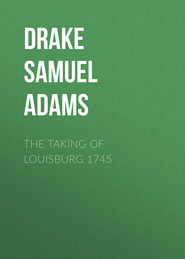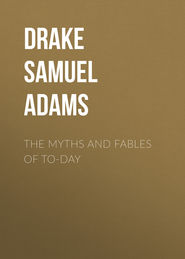По всем вопросам обращайтесь на: info@litportal.ru
(©) 2003-2024.
✖
The Battle of Gettysburg 1863
Настройки чтения
Размер шрифта
Высота строк
Поля
The Union corps would not average ten thousand men present in the ranks, although the Sixth bore sixteen thousand on its muster rolls. Some corps had three, some two divisions. There were too many corps, and in consequence too many corps commanders, for the best and most efficient organization.
51
This was Pickett's, left at Chambersburg to guard the trains.
52
Lee's corps commanders in council seem more like a debating society: Meade's more like a Quaker meeting.
53
On the night of the first, the Confederate right did not extend much, if any, south of the Hagerstown, or Fairfield, road. As the fresh troops came up they were used in extending the line southward. Anderson's division was the first to move down to Hill's left. It was his skirmishers that first became engaged with Sickles'.
54
We have seen Meade first planning an attack on that side, which was why he was drawing troops over there. He designed having the Third Corps occupy the position vacated by Geary, however, and so directed.
55
In consequence of his exhausted condition, from incessant marching and fighting, Buford was to be relieved by other troops.
56
General Daniel E. Sickles, commanding the Third Corps.
57
The enemy were seeking to mask their movements to the Union left behind these skirmishers.
58
The peach-orchard knoll was Sickles' bugbear. He thought it much to be preferred to the position he was in. It was, however, fully commanded from Little Round Top.
59
This refers to the swale next north of Little Round Top.
60
Though forming part of Reynolds' command, Sickles was halted between Taneytown and Emmettsburg by Meade's order.
61
Sickles claimed at first that he could not find the position assigned him, namely, that vacated by Geary. The force of this plea will be best appreciated by old soldiers. But in the following remarks all such clumsy pretexts are thrown to the winds; he here takes praise to himself for ignoring his commanding officer. It might be called a plea for insubordination.
"It may have been imprudent to advance and hold Longstreet at whatever sacrifice, but wasn't it worth a sacrifice to save the key of the position? What were we there for? Were we there to count the cost in blood and men, when the key of the position at Gettysburg was within the enemy's grasp?" (How did Sickles know this?) "What little I know of conduct on a battlefield I learned from Hooker and Kearney." (Kearney was a strict disciplinarian.) "What would Hooker or Kearney have done, finding themselves in an assailable, untenable position, without orders from headquarters as to their dispositions for battle, when they saw masses of the enemy marching to seize a vital point? Would they have hesitated? Would they have sent couriers to headquarters and asked for instructions what to do? Never, never! Well, I learned war from them, and I didn't send any. I simply advanced on to the battlefield and seized Longstreet by the throat and held him there." —Sickles' Music Hall Speech, Boston, 1886.]
62
John Stark's famous maxim, that one fresh man in battle is worth two fatigued ones, will be heartily endorsed by all who have seen it put to the test.
63
The two roads, Emmettsburg and cross-road, lay on converging ridges, which formed the angle at the orchard. It was a very irregular line, however, running first round the orchard, then along a ravine at the edge of the wheat-field to the Devil's Den, and again across this to the hollow, where it swung back so as to embrace the Den.
64
Lee's order of battle had been made in the belief that by throwing Longstreet across the Emmettsburg road he would envelop the Union army's proper left, whereas we have seen that he was wholly at fault, until Sickles made a condition where it did not exist before.
65
In their effort to keep out of sight the enemy lost two hours. Two hours sooner they would have occupied the orchard without hinderance.
66
The enemy took three guns here that could not be got off.
67
Vincent's and Weed's brigades of the Fifth Corps were thrown upon Little Round Top in succession, each regiment going in under fire.
68
"The battery went up that rocky hill, through the woods on the east side, at a trot, with spurs and whips vigorously applied. I do not believe a piece barked a tree … we went there at a trot, each man and horse trying to pull the whole battery by himself." —Lieut. Rittenhouse.
69
Kershaw and Semmes were both driven back to the Rose house, the former losing over six hundred men, the latter being killed; but Barksdale, supported by Wofford, bore down all opposition, thus allowing the defeated brigades to rally and come up again.
70
The whole history of this day shows that Hill's corps had been too badly hurt on the first to take any efficient part on the second. Practically Longstreet was left to fight it out alone.
71
At the close of the day the enemy held, on the left, the base of the Round Tops, Devil's Den, its woods, and the Emmettsburg road; on the right he had effected a lodgement at Culp's Hill.
72
To this day the woods show the destructive effects of this cannonade.
73
"I instructed the chiefs of artillery and battery commanders to withhold their fire for fifteen or twenty minutes after the cannonade commenced, then to concentrate their fire with all possible accuracy upon those batteries which were most destructive to us, but slowly, so that when the enemy's ammunition was exhausted we should have enough left to meet the assault." —Gen. Hunt, Chief of Artillery.
74
Pickett's division with two brigades absent was probably five thousand five hundred strong, Heth's not less, and the three supporting brigades as many more. The troops were no doubt selected as the very best that offered.











